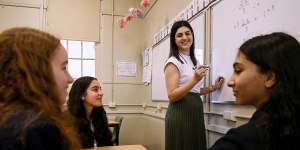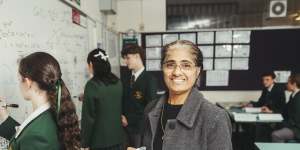The school’s voluntary maths club,for students enrolled in higher-level HSC courses,has become a regular informal study session where a maths teacher guides the group as they tackle tough questions from past exam papers.

At Riverside Girls High,the success rate for advanced maths – the ratio of high scores to total HSC exams sat – rose from 12 per cent in 2019 to 25 per cent last year.Kate Geraghty
“We get to know our students very well from that extra time outside the confines of normal classes. The club is casual but interactive,and helps us pinpoint any gaps in knowledge quickly,” says the school’s head of maths,Eleanor MacIntyre.
Riverside’s principal Louise McNeil says the maths club is just one of multiple strategies that has contributed to steady improvements in HSC maths results in recent years.
The school had an average HSC score of 82 for the extension 1 maths course in 2022,rising from 70 four years earlier. In advanced maths,the average score jumped from 74 to 80 in the same period,while the proportion of students scoring the top band in the subject has doubled.
This year,a quarter of the year 11 cohort are enrolled in the extension 1 course.
“We have highly structured lessons and the teacher constantly checking in to provide feedback,model examples and adjust activities to suit the students,” said McNeil.

”We have vertical whiteboards on the walls and encourage students to stand up and demonstrate learning to the class as they work on complex problems. There is a culture of high expectations,a focus on explicit teaching and we have embraced a whole school approach to numeracy,so teachers who take geography,music and economics are now embedding maths in their lessons,” she said.
Riverside Girls’ push to boost maths results comes as a new report from Australian Mathematical Sciences Institute,released on Tuesday,reveals the national participation rates in high-level maths courses has hit record lows after the number of students taking calculus-based courses plummeted in 2020.
About 26.7 per cent of year 12 graduates studied maths at an intermediate level in 2022,falling from 34.9 per cent in 2008.

Killara High School’s head of mathematics,Rema Nath.Dion Georgopoulos
Just nine per cent were enrolled in higher-level maths (the equivalent of extension courses in NSW),down from 10.6 per cent a decade ago. The proportion of girls studying higher level maths has collapsed to a record low of 6.4 per cent.
AMSI director Tim Marchant said the proportion of students taking more advanced,calculus-based levels of maths,which prepare senior students for university,is in longstanding decline.
“We need to get more careers information back to parents when kids are in years 9 and 10 to showcase careers linked to maths,” he said.
Marchant is especially concerned about in response to the declining number of HSC students taking the subject.

“For our whole STEM pipeline – and a whole set of degrees – there’s a certain minimum maths knowledge needed. I understand why some unis have done it,but I am concerned about the message its sending. We also have an entrenched maths teacher shortage,and 30 to 40 per cent of mathematics teachers are teaching outside their area of expertise.”
In NSW,enrolments in advanced and extension maths courses have flatlined over the decade,although the proportion of girls taking the highest level maths course fell to its lowest on record in 2023.
Engineers Australia chief executive Romilly Madew said the maths crisis is a “ticking time bomb for Australia,hindering the nation’s capacity to compete globally.
“A deficit in maths educators equates to a deficit in engineering talent[which has] profound implications for Australia’s future prosperity. If primary school students exit with adequate maths literacy,the transition to secondary maths subjects becomes less daunting,” Madew said.
The head of maths at Killara High,Rema Nath,who has taught at the school for 16 years,said while lessons are not streamed in year 7 and 8,students entering the middle years of high school can be moved into advanced classes.
Nath said the first 10 minutes of every maths lesson at Killara is used to cover previous content,an activity that “also acts to calm the students and orient them in the lesson”. The school,where 40 per cent of students achieved a band six in advanced maths last year,also has an “exit ticket” task which assesses students on the knowledge they’ve picked up in the lesson.

“The most important thing is to make sure that any gaps in their understanding are filled before they are moved into different classes,” she said.
Nath is adamant years 8 and 9 are the key grades for preparing students with foundational knowledge for HSC maths.
“That’s when the areas of number and algebra need to be really solid. From year 9 onwards,it starts moving into different directions. If we have a strong year 8 class it will just flow from there.”
A spokesperson for the NSW Education Standards Authority said the new syllabus should encourage more students into higher level maths by including a “core” unit of work in years 9 and 10 which teachers can top up with additional content to stretch students.
“Our new mathematics syllabuses represent a significant shift in syllabus design that will not only provide solid foundations for all levels of learning,but support more students to pursue the highest levels of maths,” they said.
with Nigel Gladstone
Start the day with a summary of the day’s most important and interesting stories,analysis and insights..